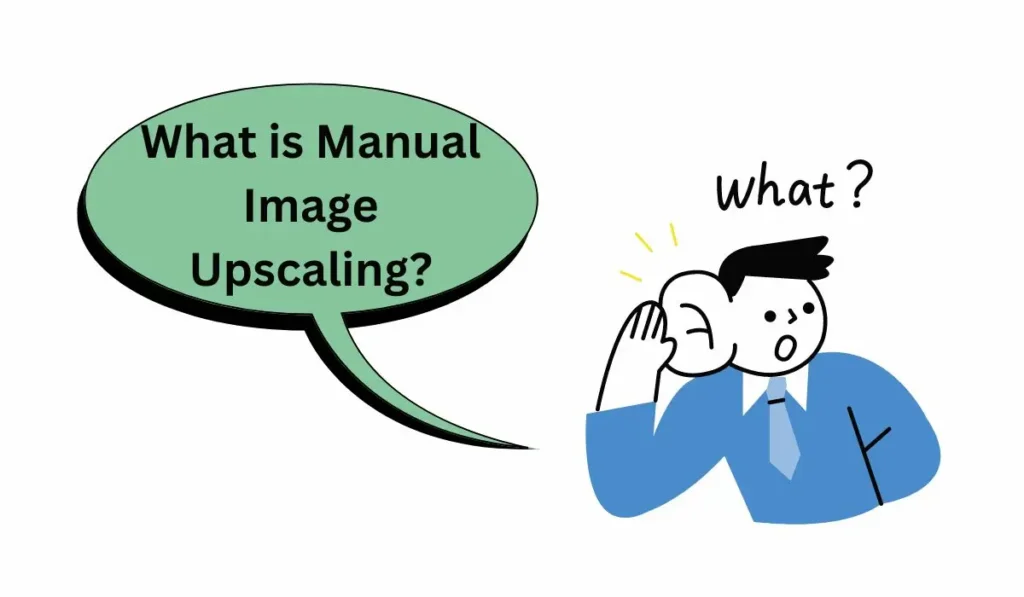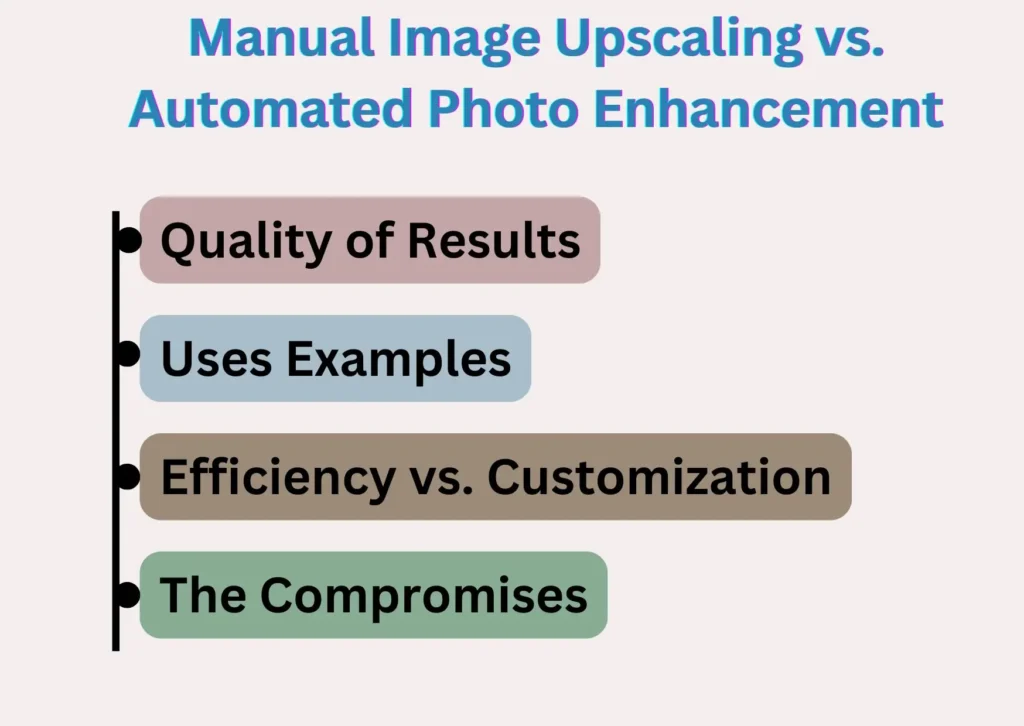Manual image upscaling and automated image enhancement are the two main approaches for image upscaling in digital media. Manual image upscaling is the process where an experienced professional employs specific software to enhance and magnify images practically. This method gives the user more control over any part of the image but the user needs to Practice and be patient with this Technique.
This trend in image processing automation is partially driven by the increasing need for high-resolution images. Not only are these AI-driven tools automated solutions closer to those attained using manual methods faster, but they continue to get better. What remains to be seen, though, is when automation should take place and when the human touch is preferable. This blog post will take a look at these two methods of image upscaling, and discuss the good aspects, not-so-good aspects as well as when to use them.
What is Manual Image Upscaling?

Manual image upscaling is a fancy way of saying a user modifies an image by hand to boost its resolution. Human upscaling gives you a lot more control over the outcome than automated methods that have to leave it all in the hands of the original systems. This approach is specifically useful in cases where you are required to make exact alterations to keep the original look or ensure a kind of artistic intention.
Manual Image Upscaling Tools
In manual upscaling, there are some well-known software programs that offer a lot of control
1. Adobe Photoshop
is an efficient tool for editing images and upsizing just as professionals worldwide use regularly. While Photoshop is also quite used in this regard, there are more advanced tools for edge enhancement and sharpening as well as an array of interpolation techniques available.
2. GIMP (GNU Image Manipulation Program)
The free and open-source, which offer more tools for this type of training than photoshop: a dozen interpolation algorithms, and custom upscaling filters.
3. Affinity Photo
Another professional-level product, which is also a pro-level offering, is famous for its image editing that goes deeper with options like manual upscaling on-par with Photoshop.
Benefits of Manual Image Upscaling
Total Creative Freedom:
Since users can adjust every step of the process their manual upscaling ensures that the finished image fits according to their requirements and liking. This level of control is especially important for any creative project as the end result must be in a specific style.
Expert-Level Accuracy:
As an informed user, you can select different upscaling approaches to preserve the highest quality of the media and keep textures/details that may be lost automatically.
Individualization:
In the event that each and every picture can be managed separately, you may get actual improvements which will struggle to possess through automated programs made for one sizing meets just about all. For the more intricate or original images, this is a must.
Pros and Cons of Manual Image Upscaling
Time-consuming:
Working with a lot of images or large projects, the manual is quite time-consuming and certainly requires some effort. This means every image has to be processed very meticulously to achieve the desired effect, which is often time-consuming and highly laborious.
Requires Expertise:
It requires experience and practice to truly master manual upscaling techniques. You can easily make blunders if the knowledge is not perfect, which may also cause a blurred image.
Inconsistency:
As manual upscaling is based a lot on the choice of user, so there can be some differ in quality (especially if different people upscale Images) Results are hard to achieve across a huge amount of images.
What is Automated Photo Enhancement?

Photo enhancer services are nothing but enhancement of various attributes of an image such as the resolution, quality, and appearance using advanced algorithms based on artificial intelligence. Compared to the traditional manual upscaling, human intervention and decisions are involved in the processing, while automated enhancement aims to streamline that process making it faster and easier for users of all levels.
Tools and Software
1. Topaz Gigapixel AI:
The best product in this respect, applies superresolution using artificial intelligence to enlarge images while retaining the details. The excellent thing about Illustrator is that even small details come out rad when the illustrator in question knows what they’re doing.
2. Adobe Super Resolution:
This is an AI-powered tool available in Adobe’s arsenal, and it uses AI to boost the resolution of an image at once. It is made for photographers wishing to quickly adjust their photos and tweak them without lowering the quality. Broadly speaking, like its companions in the Software Development Kit (SDK), this feature was made available as part of Adobe Camera Raw and Lightroom.
3. Let’s Enhance:
A site that uses AI to upscale images without making them larger. It is a popular choice among casual users due to its ease of use and widespread availability even among those who have no advanced experience.
Advantages of Automated Photo Enhancement
Speed and Quality:
The speed at which automated photo enhancement processes photos is one of the strongest advantages of such a solution. AI-powered technologies will complete work that might take hours or days to finish by the human hand in a few minutes or seconds. For this reason, it is great for professionals, especially those who have to grapple with large amounts of images.
Consistency:
Automated systems provide a high degree of consistency when processing large image collections. Every picture is handled in the exact same way, simply fixing to precisely the same extent. Hence considered valuable in industries like e-commerce where consistency of image quality is maintained.
Challenges of Automated Photo Enhancement
Lack of creative Control:
If automated methods are effective, human upscaling often requires more creative control. The magic of the method is restricted to a good extent so doing an individual look or simply trying exact alterations is difficult. For illustrations where
Possibility of Over-Processing:
Some machine learning techniques can be over-aggressive in their adjustments leading to artificial, waxy results from your re-touched images. For instance, over-sharpening can make edges sharp and noise reduction may blur fine details.
Dependency on Technique Quality:
The quality of enhancement directly depends on the basic method. While not all AI technologies are created equal, meaning some may perform better than others. It is important to be careful in choosing the tools because the wrong tool can create worse results.
Manual Image Upscaling vs. Automated Photo Enhancement

With digital media always changing, image quality is important. A professional photographer, graphic designer, or someone wishing to improve their images can all benefit from using the appropriate image upscaling technique. Two main methods are available: automated photo enhancement and manual image upscaling. Each has advantages and disadvantages; the most suitable choice frequently depends on your requirements and desires.
Quality of Results
When it comes to the quality of results, both manual and automated methods have their distinct advantages.
Manual Image Upscaling:
Output Quality: The end results with manual upscale are amazing in the hands of an artist. It enables exact corrections in some parts of the image, which automated methods often struggle with. It sounds a little strange because a designer will still have to make sure sharpness is up on critical areas of the image while keeping the overall aesthetics in check.
Where It Excels: In projects that require exact detail accurately conveyed in the video. This technique is especially handy to bring back old photographs or for fine art, or even when preparing images for large prints since each pixel can be so important.
Automated Photo Enhancement:
Output Quality: AI technology has made a huge difference in improving the quality of any automated photo improvement. You also have popular tools such as Topaz Gigapixel AI and Adobe Super Resolution which excel at upscaling low-resolution images while preserving a natural look drastically reducing noise and enhancing the details of your photos. But sometimes these tools miss something that a human eye may catch.
Where It Excels: Automated optimization is best for situations in which you should have to move away from it in a hurry and its overwatch rushing. For example, if you are taking over a website with hundreds of products on their webpage, they likely use automated tools to quickly and consistently deal with images associated with those products across the site.
Uses Examples
Selecting between automated and manual processes frequently depends on the particular use circumstances.
Manual Image Upscaling:
- Creative Projects: Manually upscaling is also ideal if the work you generate demands a lot of creative control. For work like digital art, high-end photography or intricate photo restoration, this attention to detail is important.
- Complex Images: In some cases, the detracting part of an imagine is difficult to upscale, or requires special enhancements that an automated tool might no be able to achieve.
Automated Photo Enhancement:
- Large-Scale Projects: In the case of bulk image processing like e-commerce or Publishing, automated tools can save a massive amount of time. They automatically handle scaling their code to hundreds or thousands of images, each independently quality verified.
- Time-Sensitive Tasks:
When you are in a hurry to get something done, tools that enhance automation are very useful. That is, to process the images for use in a news article or prepare them with good quality to paste on social media without having much to do manually.
Efficiency vs. Customization
Another important factor to consider is the balance between efficiency and customization.
Efficiency:
Automated Tools: The biggest benefit of automated photo enhancement is speedy. So instead of spending hours resizing images at a snail’s pace, image upscaler tools can do it in no time. It is essential, especially for professionals who have tight timelines and are given vast amounts of work to do. Moreover, automated tools ensure consistent results with every image, which is a must to make sure of uniform graphic design.
Customization:
Manual Techniques: Manual upscaling is more tedious, but offers the highest level of customization. All details of each cannot be adjusted corresponding to the use case (preserve texture, enhance some area, or special-look art) Control of this degree is necessary in a creative area where the end product needs to be flawless for an exacting vision.
The Compromises
The decision between automated and manual procedures ultimately comes down to a compromise between quality and time.
Time vs. Quality: Automated tools yield lightning-fast performance with a high rate of success, so they are an excellent option for fast-paced settings Still, for the utmost in quality, particularly when it comes to critical jobs, manual upscaling will permit a degree of fine-tuning that automated methods might not be able to meet.
Consistency vs. Personalization: Automated tools are great at being consistent (especially if you have a lot of images) But manual upscaling, when correctly done, gives you a human touch that will make your final result unique and actively help in achieving certain goals.
Conclusion
It is not always about personal preference, the choice between automated image upscaling and manual photo enhancement has to be guided by your tools and techniques towards the goal that you are trying to achieve with your images. Creative work that demands high precision and a lot of human touch is better suited to be done by hand in order to maintain the highest control necessary for some features of an image Meanwhile, automatically enhancing an image is extremely well executed: it performs correct wonderful results in a fraction of the time, notably if you have a large batch from images to solve.





